Astronomers have achieved a groundbreaking milestone by producing the first three-dimensional map of an exoplanet, named WASP-18b, using the James Webb Space Telescope. This significant advancement in exoplanet research was made possible through the innovative technique known as 3D eclipse mapping, which allows scientists to track subtle changes in light wavelengths as WASP-18b transitions behind its host star.
Through this method, researchers were able to reconstruct temperature variations across different latitudes, longitudes, and altitudes on the planet. “If you build a map at a wavelength that water absorbs, you’ll see the water deck in the atmosphere, whereas a wavelength that water does not absorb will probe deeper,” explained Ryan Challener, a postdoctoral associate in Cornell University’s Department of Astronomy and lead author of the study. “If you put those together, you can get a 3D map of the temperatures in this atmosphere.”
WASP-18b is situated approximately 400 light-years from Earth and boasts a mass nearly ten times that of Jupiter. It orbits its star in just 23 hours, resulting in extreme atmospheric conditions that reach nearly 5,000 degrees Fahrenheit (about 2,760 degrees Celsius). These intense temperatures made WASP-18b an ideal candidate for testing the new mapping technique.
The resulting map revealed a bright central hotspot on the planet’s dayside, surrounded by a cooler ring. Because WASP-18b has a tidally locked orbit, one side consistently faces its star, leading to uneven heat distribution across the atmosphere. Notably, the hotspot exhibited lower water vapor levels than the planet’s overall atmospheric average. “We think that’s evidence that the planet is so hot in this region that it’s starting to break down the water,” Challener noted. “That had been predicted by theory, but it’s really exciting to actually see this with real observations.”
This innovative 3D eclipse mapping technique represents a significant leap forward for exoplanet studies. As Challener pointed out, it allows astronomers to image exoplanets that are otherwise obscured by their bright host stars. “As 3D eclipse mapping is applied to other exoplanets observed by Webb, we can start to understand exoplanets in 3D as a population, which is very exciting,” he added.
The team’s research, detailing these findings, was published in the journal Nature Astronomy on October 28, 2025. This development not only enhances our understanding of WASP-18b but also opens new avenues for exploring the atmospheres of distant planets, potentially altering the future of exoplanet research.







































































